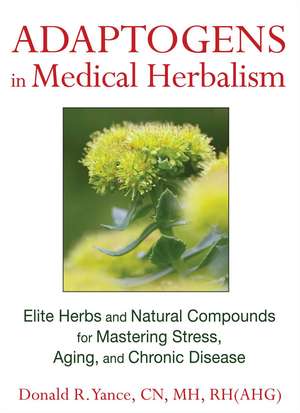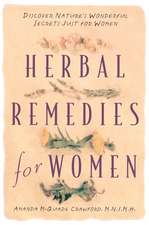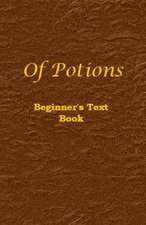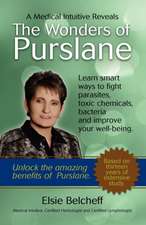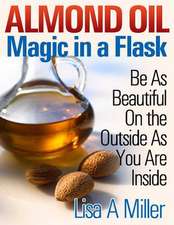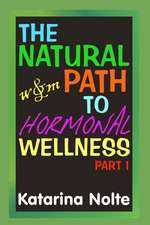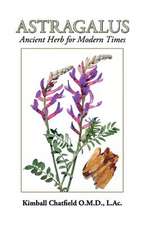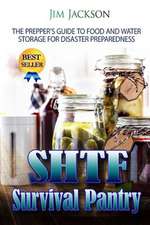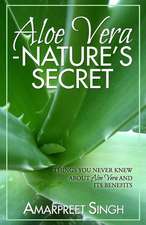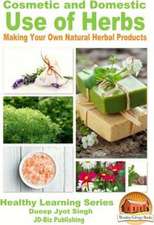Adaptogens in Medical Herbalism: Elite Herbs and Natural Compounds for Mastering Stress, Aging, and Chronic Disease
Autor Donald R. Yance CN, MH, RH(AHG)en Limba Engleză Hardback – 21 sep 2013
Weaving together the ancient wisdom of herbalism and the most up-to-date scientific research on cancer, aging, and nutrition, renowned medical herbalist and clinical nutritionist Donald Yance reveals how to master stress, improve energy levels, prevent degenerative disease, and age gracefully with the elite herbs known as adaptogens. Yance’s holistic approach, called the Eclectic Triphasic Medical System (ETMS), is based on extensive scientific research, more than 25 years of clinical practice, and excellent results with thousands of patients. It centers on four interconnected groups of health tools: botanical formulations, nutritional supplements, diet, and lifestyle. Defining three categories for adaptogenic herbs, he explains how formulations should combine herbs from each category to create a synergistic effect. He provides more than 60 monographs on herbs and nutritional compounds as well as custom combinations to revitalize the immune system, build cardiovascular health, protect brain function, manage weight, and support cancer treatment. He explains the interplay of endocrine health, the hypothalamic-pituitary-adrenal (HPA) axis, thyroid function, and stress in the aging process and reveals how adaptogenic treatment begins at the cellular level with the mitochondria--the microscopic energy producers present in every living cell. Emphasizing spirituality, exercise, and diet in addition to herbal treatments and nutritional supplements, Yance’s complete lifestyle program explores how to enhance energy production in the body and subdue the proinflammatory state that lays the groundwork for nearly every degenerative disease, taking you from merely surviving to thriving.
Preț: 257.28 lei
Preț vechi: 328.03 lei
-22% Nou
49.23€ • 51.40$ • 40.65£
Carte disponibilă
Livrare economică 28 martie-09 aprilie
Specificații
ISBN-10: 1620551004
Pagini: 672
Ilustrații: 25 b&w illustrations
Dimensiuni: 216 x 279 x 41 mm
Greutate: 1.81 kg
Editura: Inner Traditions/Bear & Company
Colecția Healing Arts Press
Notă biografică
Donald R. Yance Jr., CN, MH, RH(AHG), is a clinical master herbalist and certified nutritionist. He is the founder of the Mederi Centre for Natural Healing in Ashland, Oregon, the president and formulator of Natura Health Products, and founder and president of the Mederi Foundation. He lives in Ashland, Oregon.
Extras
ADAPTOGENS AND THE HEALING RESPONSE
From Surviving to Thriving
All living organisms--including animals, plants, and even bacteria--survive because of their innate or acquired abilities to respond appropriately to the ever-changing environment. Remarkably, many compounds that are vital to a plant’s ability to adapt also help humans adapt to life stressors through an ancient and beneficial relationship that we are just beginning to understand.
Adaptation can be broadly classified into two categories: functional adaptation, which helps the organism to survive, and reproductive adaptation, which ensures the survival of the organism’s genetic material--an organism cannot be considered successful if its type goes extinct. Although the process of adaptation may be easier to observe in animals, adaptation is essential for all living things. Plants have undergone adaptation since they first appeared on Earth, and their survival strategies are exemplified by their amazing variability of adaptive changes. One easily observable example is the changing colors of leaves in the fall. Chlorophyll, the green pigment responsible for photosynthesis, disappears as the days grow shorter. This allows an array of flavonoids, which are always present in the leaves, to appear. Flavonoids give leaves their beautiful fall colors. But these colors provide more than just beauty. Plants produce these compounds as an adaptive measure as sunlight diminishes and the weather cools to aid in the storage of nutrients and to ward off damaging insects.
These strategies are an illustration of adaptation that originates in organically coded information within the organism. What is most remarkable is that this plant-based information can be directly communicated to the human genome. For example, instead of having to live on the frozen tundra in order to increase our capacity for hardiness, adaptive capacity can be conveyed directly to us through the use of appropriate botanical medicines--specifically, by a unique class of herbs known as adaptogens. Revered in traditional medical systems, these herbs are often referred to as “elite,” or “kingly,” because they enhance one’s inner vitality, encourage a state of balance, and increase endurance. In recent history Soviet researcher Dr. Israel Brekhman gave this category of plants the name adaptogens for their unique ability to help the organism adapt to the changing conditions of life.
ADAPTOGENS DEFINED
The core essence of adaptogens is that they combat the negative effects of stress and improve resistance, thereby improving our health and well-being. Essentially, adaptogens help us to live with greater mental and physical endurance and vitality, while mitigating the cost of stressors and building our reserves through enhancing our regenerative (anabolic) capacities.
An adaptogenic herb is traditionally regarded as one that meets the classical definition as described by Brekhman.
- Adaptogens are safe with no significant side effects or contraindications.
- Adaptogens have a general, nonspecific action to improve resistance to stress.
- Adaptogens have a balancing, normalizing effect on body functions, regardless of the origin of disruption or the direction of the homeostatic disturbance.
In my clinical practice I distinguish three main categories of adaptogens and use herbs from each of these categories in all of my formulations to achieve the best possible results.
Primary adaptogens: Meet the classical definition of adaptogens.
Secondary adaptogens: Meet most of the traditional criteria or have met all of the criteria but lack sufficient scientific validation.
Adaptogen companions: May not meet all of the traditional criteria but play a supporting role by enhancing the HPA axis and anabolic metabolism.
Primary Adaptogens
Primary adaptogens meet very specific criteria, have solid scientific research validating their use as adaptogens, enhance the general resistance of the entire body, act in a nonspecific manner, and have a normalizing effect against all forms of stress.
The activity of primary adaptogens is focused on metabolic regulation through their proven effects on the hypothalamic-pituitary-adrenal (HPA) axis during stress-adaptation responses. They have an ability to maintain or restore homeostasis and allostasis and encourage anabolic restoration. Primary adaptogens enable better response and recovery because they help to smooth out the highs and lows of the neuroendocrine stress response by regulating and normalizing the hormones involved. Primary adaptogens strengthen all systems, promote optimal response and hasten recovery of function, and help to regulate energy use by enhancing cellular energy transfer. Adaptogens enable us to make more efficient use of oxygen, glucose, lipids, and proteins.
Some specific positive results of the HPA regulation provided by primary adaptogens include the following:
- Increasing and modulating the flow of energy throughout the day
- Decreasing feelings of stress
- Increasing endurance
- Supporting mental alertness
- Promoting deep, restful sleep
Secondary Adaptogens
I classify herbs as secondary adaptogens when they meet most, but not all, of the criteria of primary adaptogens. Although secondary adaptogens demonstrate some normalizing activity, especially of the immune, nervous, and hormonal systems, they may not directly support the HPA axis.
The protective effects of secondary adaptogens come with regular use when combined with primary adaptogens. Secondary adaptogens share the following attributes:
- Their normalizing activity focuses on the immune, nervous, or endocrine systems.
- Their activity may not directly support the HPA axis.
- While they may meet some, or most, of the qualifications of primary adaptogens, they have yet to be studied extensively.
- Many of these plants are rich in fatty acids, sterols, and phenolic compounds.
- Many of these plants enhance anabolic metabolism.
Herbal Adaptogen Companions
While this third group of herbs has demonstrated enormous general health benefits similar to those of primary and secondary adaptogens, they do not meet the criteria to be officially termed adaptogens. Thus, I call them adaptogen companions, because their actions enhance or synergize the effects of primary and secondary adaptogens. An herb such as green tea falls under this classification. I also include specific nutritional agents in this classification.
This elite group of herbs and nutritional compounds is used in a supporting role to potentiate primary herbs, harmonize formulations, and, most often, to add high nutritive value. When combined with primary and secondary adaptogens they will significantly increase life span and quality of life.
Elderberry
Sambucus nigra, Sambucus spp.
Plant family: Caprifoliaceae (Honeysuckle Family)
Other common names: Elder flower, elder leaf
Parts used: Leaves, flowers, berries, inner bark
OVERVIEW AND AUTHOR’S COMMENTARY
Elderberry (Sambucus spp.), as well as elder flower and leaf, grow all over the North American Northwest and have long been used in traditional Western medicine. Elder flower and leaf are in classic diaphoretic teas, and together with elderberry are ingredients in my “Flew Away” formula, a classic formula for colds and flu. Elderberry is also in Vital Adapt, my general adaptogenic tonic formula.
Elderberry is used as a general nutritive tonic, providing a high concentration of flavonoids, as well as an immune tonic to prevent and alleviate many cold and flu symptoms including runny nose, cough, sore throat, fever, and muscle pain. Elderberry is especially great for children in the fall in winter as an overall immune tonic.
Therapeutic Dosing Range
- Fluid extract 1:1 2-5 ml.: 1-2 times daily
- Standardized Extract (5% Total Flavonoids): 500-2000 mg. daily
- Tea (may be mixed with leaf and flower): 2-6 caps daily
Safety Profile
There are no known adverse reactions to elderberry.
Habitat and Cultivation
The black or common elder is a small tree or shrub with dark purple berries and white to light-yellow flowers. It blooms in June and July, and the berries mature in September and October. The flowers, berries, and inner bark are used as medicine. S. nigra is indigenous to Europe, growing in conditions similar to those of the American variety. In the United States, it grows in low, damp grounds, thickets, and waste places. The two plants possess similar medicinal properties.
Key Constituents
The berries are rich in vitamin C and a wide range of important flavonoids, including quercetin and anthocyanins, which are believed to account for the therapeutic effects. The leaf and flowers contain flavonoids, such as anthocyanins, carotenoids, essential oil, mucilage, and tannins. Among individual phenolic compounds are quercetin and kaempferol compounds, phenolic acids, and anthocyanins.
TRADITIONAL USE
Elderberries have long been used as food, particularly in the dried form. Elderberry wine, pie, and lemonade are some of the popular ways to prepare this plant. The leaves were touted to be pain relieving and to promote healing of injuries when applied as a poultice. Native Americans used the plant to treat infections, coughs, and skin conditions. In a warm infusion, elder flowers are diaphoretic and gently stimulating. In cold infusion, they are diuretic, alterative, and cooling. The flowers and expressed juice of the berries have been beneficially employed in scrofula, cutaneous diseases, syphilis, rheumatism, and so forth. The inner bark of Sambucus nigra is an emetic and cathartic and has been successfully used to treat epilepsy.
MODERN RESEARCH
- Elderberry extract possesses significant antioxidant activity and has been shown to impair angiogenesis.
- Nonspecific Immune Enhancement. Elderberries boost cytokine production. A unique protein found in elderberry acts as a messenger regulating immune response.
- Elderberry is a potent viral inhibitor. Its anti-influenza ability is much researched in both
Israel and Switzerland. Elderberry extract has also been shown to inhibit herpes virus and HIV in cell culture. The H1N1 inhibition activities of the elderberry flavonoids compare favorably to the known anti-influenza activities of Oseltamivir (Tamiflu; 0.32 microM) and Amantadine (27 microM).
- The anthocyanins present in elderberries protect vascular epithelial cells against oxidative insult, preventing vascular disease. Elderberry has shown to reduce LDL cholesterol and atherosclerosis.
- Elderberry could improve bone properties by inhibiting the process of bone resorption and stimulating the process of bone formation.
Cuprins
Acknowledgments and Dedication
Foreword by Dwight L. McKee, MD, CNS, ABIHM
Introduction
Part One
Adaptogens
Keys to Optimal Health
1. My Healing Philosophy
2. Adaptation and the Stress Response
3. Vital Energy and the Neuroendocrine System
4. The Metabolic Model of Aging
5. Adaptogens, the Ultimate Evidence-Based Medicine
6. Adaptogen-Based Formulations as the Foundation of Health
7. Harmonizing with Adaptogenic Blends
8. The Thyroid and the HPA Axis
9. Cardiovascular Health
10. Revitalizing the Immune System
11. Adaptogenic Remedies in Cancer Therapy
12. Healthy Brain and Aging in the Metabolic Model
13. Bone Health
14. Weight Management
15. Exercise, the Best Medicine
16. Eating for Optimal Health
17. Mastering Life and Wellness through Spirit
Conclusion to Part 1. The Future of Medicine
Part Two
Materia Medica
Acerola - Malpighia glabra
Alpha-Lipoic Acid
Amla/Indian Gooseberry - Phyllanthus emblica
Aralia - Aralia elata
Ashwagandha - Withania somnifera
Astragalus - Astragalus membranaceus
B Vitamins: B5, B6, B12, and Folic Acid
Bacopa - Bacopa monnieri
Bilberry - Vaccinium myrtillus
Branched-Chain Amino Acids (BCAAs)
Coenzyme Q10 (Ubiquinone)
Colostrum
Cordyceps - Cordyceps sinensis
Creatine
Devil’s Club - Oplopanax horridus
Elderberry - Sambucus nigra, Sambucus spp.
Eleuthero - Eleutherococcus senticosus
Epimedium - Epimedium grandiflorum, E. brevicornum, E. sagittatum, E. koreanum
Eurycoma - Eurycoma longifolia
Fish Oil Rich in EPA and DHA
Ginger - Zingiber officinale
Ginseng - Panax ginseng, P. quinquefolius
Glutamine
Goji Berry - Lycium barbarum, L. chinense
Gotu Kola - Centella asiatica
Grape Seed, Grape Skin, and Japanese Knotweed (Hu Zhang) - Vitis vinifera and Polygonum cuspidatum
Green Tea - Camellia sinensis
Hawthorn - Crataegus spp.
He Shou Wu - Polygonum multiflorum
Holy Basil - Ocimum sanctum
L-Arginine
L-Carnitine
L-Tryptophan
Licorice - Gycyrrhiza glabra, Glycyrrhiza spp.
Magnesium
Marapuama - Ptychopetalum olacoides, P. uncinatum
Mucuna - Mucuna pruriens
Mumie - Asphaltum
NADH
Nettle - Urtica dioica
Notoginseng - Panax notoginseng, P. pseudoginseng
Oat Seed - Avena sativa
Pantethine
Pantocrine - Cornu Parvum Cervi
Poria (Fu Ling and Fu Shen) - Poria cocos
Reishi - Ganoderma lucidum
Rhaponticum - Rhaponticum carthamoides
Rhodiola - Rhodiola rosea
Rooibos - Aspalathus linearis
Rose Hips - Rosa canina
Rosemary - Rosmarinus officinalis
Royal Jelly (and Propolis) - Substances produced by Apis mellifera
Saw Palmetto - Serenoa repens, S. serrulata
Schisandra - Schisandra chinensis
Shatavari - Asparagus racemosus
Siberian Pine Seed Oil - Oleum Pini Sibericae
Siberian Sea Buckthorn Oil - Oleum Hippophae Sibericae
Suma - Pfaffia paniculata
Tribulus - Tribulus terrestris
Turmeric - Curcuma longa, C. domestica
Tyrosine
Vitamin D3
Whey Protein Concentrate
Appendix. The Eclectic
Triphasic Medical System (ETMS)
Index
Recenzii
“Donnie Yance has done it again! Nowhere has such a voluminous and practical assortment of valid information about adaptogens been assembled in such a readable and useful format. I will be using this book in my research, in my daily life, and whenever I have a question about an ingredient I am using.”
“Adaptogenic herbs, considered elixirs in many traditional cultures, have activities that move us beyond surviving into thriving. Their effects would seem almost unbelievable and magical if there wasn’t such strong science to back them up. They are, perhaps, the most important medicines we have for not only surviving, but thriving in this age. Donald Yance brings these herbs to you through their history, science, and his vast clinical experience, giving you the tools you need to revitalize your life. This is a must read for all of us who want to live up to our optimal capacities and then some!”
“Donald Yance probably knows more about treating cancer with herbs and alternative therapies and has helped more people with this dreaded disease than any other herbalist in the world. His depth of knowledge, commitment, and passion for his work and the people he cares for are legendary. In his new book on adaptogens, Donald brings the same level of research and detailed clinical insights to this important class of herbs that made his previous book on cancer a classic text.”
“A breakthrough in herbalism! This book should be in every household.”
“This is a wonderful, deeply informative, and comprehensive book… I strongly recommend Adaptogens in Medical Herbalism to anyone who is devoted to preventing, healing, or recovering from a chronic condition. It is my hope and prayer that this book becomes a mainstay in general public education and dialogue, as well as in integrative medicine and integrative oncology.”
“Ancient wisdom tells us that adaptogens are the Imperial Herbs, the Jewels in the Golden Cabinet that nourish, replenish, rejuvenate, restore, and promote longevity and superior quality of life. There is no one better than Master Herbalist Donnie Yance to teach us how to combine traditional healing wisdom with modern science in the skillful use of these remarkable healing agents. Donnie brings a depth and breadth of knowledge and experience and provides not only an integrated and comprehensive view but also practical applications.”
“Western medicine needs medical herbalism and Donnie Yance provides comprehensive natural medicine knowledge of adaptogens and their companions along with insightful information on vitality and health. The book also contains useful monographs and extensive journal references for practitioners.”
“Donald Yance has yet again set a benchmark for complementary, botanical medical books. Adaptogens in Medical Herbalism is both thorough and available and it provides clear understandings of the importance of these herbs in health and disease prevention. What distinguishes Donnie’s book from the many available in the field is his grasp of the essential issues and his deep exploration of the resources demonstrated by his faultless referencing. It will become the standard by which future books will be judged.”
“This is an absolutely amazing book! Yance has approached stress, that archenemy of good health, by utilizing adaptogens (in traditional and modern applications), their supporting herbs, and your own personal level of awareness. Written with striking clarity, it is readily understood by both lay and professional herbalists, indeed, by everyone truly committed to good preventative health-care.”
“Comprehensive and extensive, Adaptogens in Medical Herbalism should be considered an essential and core addition to professional, community, and academic library Alternative Medicine & Human Health reference collections.”
Descriere
A scientifically based herbal and nutritional program to master stress, improve energy, prevent degenerative disease, and age gracefully.
